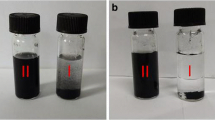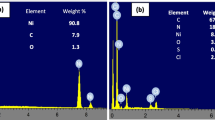Abstract
In this work, carbon nanohorn (CNH)–decorated multi-walled carbon nanotube (MWCNT) (CNH@MWCNT) composite was prepared and used to modify glass carbon electrode (GCE) as sensitive electrochemical sensor for niclosamide (NA) determination. Herein, the decoration of CNHs induces higher dispersibility for MWCNTs, and endows the composite with better conductivity, larger surface area, and higher catalytic activity, which leads to significantly enhanced electrochemical behavior toward NA oxidation. The parameters such as mass ratios of CNHs and MWCHTs, the amount of composite materials, the accumulation time, and the solution pH are systematically optimized. Under optimized conditions, the developed electrochemical sensor exhibits a low detection limit of 2.0 nM with a wide linear range of 7.0 nM–10.0 µM and high anti-interference ability. In addition, the sensor displays good stability, repeatability, and reproducibility. The feasibility of the assay was verified by testing NA in brown rice and rice field water samples.








Similar content being viewed by others
References
Kadri H, Article OA, Mehellou Y. Niclosamide, a drug with many (re)purposes. Chem Med Chem. 2018;13:287–288.
Oliveira-Filho EC, Paumgartten FJR. Toxicity of Euphorbia milii latex and niclosamide to snails and nontarget aquatic species. Ecotoxicol Environ Saf. 2000;46(3):342–50.
Zhu B, He W, Yang F, Chen L. High-throughput transcriptome sequencing reveals the developmental toxicity mechanisms of niclosamide in zebrafish embryo. Chemosphere. 2020;244:125468–78.
Xu J, Shi P, Li H, Zhou J. Broad spectrum antiviral agent niclosamide and its therapeutic potential. Acs Infect Dis. 2020;6(5):909–15.
Zhurina MV, Gannesen AV, Mart Yanov SV, Teteneva NA, Shtratnikova VY, Plakunov VK. Niclosamide as a promising antibiofilm agent. Microbiology. 2017;86(4):455–62.
Xu J, Berastegui-Cabrera J, Chen H, Pachón J, Zhou J, Sánchez-Céspedes J. Structure-activity relationship studies on diversified salicylamide derivatives as potent inhibitors of human adenovirus infection. J Med Chem. 2020;63(6):3142–60.
Choi H, Kim T, Lee S, Kim W, Noh Y, Kim G, et al. Bioanalysis of niclosamide in plasma using liquid chromatography-tandem mass and application to pharmacokinetics in rats and dogs. J Chromatogr A. 2021;1179:122862–70.
Zhurina MV, Gannesen AV, Mart Yanov SV, Teteneva NA, Shtratnikova VY, Plakunov VK. Niclosamide as a promising antibiofilm agent. Microbiology (New York). 2017;86(4):455–62.
Kartalović B, Pucarević M, Marković Z, Stanković M, Novakov N, Pelić M, et al. Determination of niclosamide and its metabolites in liver and muscles of common carp (Cyprinus carpio) fingerlings. Acta Sci Vet. 2017;45(1):6–11.
Li F, Liu R, Dubovyk V, Ran Q, Li B, Chang Y, et al. Three-dimensional hierarchical porous carbon coupled with chitosan based electrochemical sensor for sensitive determination of niclosamide. Food Chem. 2022;366:130563–71.
Ghalkhani M, Shahrokhian S. Application of carbon nanoparticle/chitosan modified electrode for the square-wave adsorptive anodic striping voltammetric determination of Niclosamide. Electrochem Commun. 2010;12(1):66–9.
Zhang Z, Yao Y, Xu J, Wen Y, Zhang J, Ding W. Nanohybrid sensor based on carboxyl functionalized graphene dispersed palygorskite for voltammetric determination of niclosamide. Appl Clay Sci. 2017;143:57–66.
Yi YF, Wang P, Fan GR, Wang ZD, Xue T, Wen YP, et al. Hierarchically porous carbon microsphere doped with phosphorus as a high conductive electrocatalyst for oxidase-like sensors and supercapacitors. ACS Sustain Chem Eng. 2020;8(26):9937–46.
Gao C, Guo Z, Liu J, Huang X. The new age of carbon nanotubes: an updated review of functionalized carbon nanotubes in electrochemical sensors. Nanoscale. 2012;4(6):1948–63.
Zhong W, Gao F, Zou J, Liu S, Li M, Gao Y, et al. MXene@Ag-based ratiometric electrochemical sensing strategy for effective detection of carbendazim in vegetable samples. Food Chem. 2021;360:130006–1300012.
Chen J, Zhu Y, Jiang W. A stretchable and transparent strain sensor based on sandwich-like PDMS/CNTs/PDMS composite containing an ultrathin conductive CNT layer. Compos Sci Technol. 2020;186:107938–45.
Lavagna L, Nisticò R, Musso S, Pavese M. Functionalization as a way to enhance dispersion of carbon nanotubes in matrices: a review. Mater Today Chem. 2021;20:100477–93.
Ghalkhani M, Shahrokhian S, Navabi M. Development of an electrochemical sensor based on (rGO-CNT) nanocomposite for raloxifene analysis. Mater Chem Phys. 2021;263:124131–123141.
Wang L, Hu D, Kong X, Liu J, Li X, Zhou H, et al. Anionic polypeptide poly(γ-glutamic acid)-functionalized magnetic Fe3O4-GO-(o-MWCNTs) hybrid nanocomposite for high-efficiency removal of Cd(II), Cu(II) and Ni(II) heavy metal ions. Chem Eng J. 2018;346:38–49.
Mani V, Dinesh B, Chen S, Saraswathi R. Direct electrochemistry of myoglobin at reduced graphene oxide-multiwalled carbon nanotubes-platinum nanoparticles nanocomposite and biosensing towards hydrogen peroxide and nitrite. Biosens Bioelectron. 2014;53:420–7.
Bricha M, El Mabrouk K. Effect of surfactants on the degree of dispersion of MWNTs in ethanol solvent. Colloid Surface A. 2019;561:57–69.
Shi L, Zhang D, Zhao JF, Yin MN, Liang AP, Ghosh S. Small organic molecules act as a trigger in an “unzippering” mechanism to facilitate carbon nanotube dispersion. Sci Total Environ. 2021;758–65.
Rennhofer H, Zanghellini B. Dispersion state and damage of carbon nanotubes and carbon nanofibers by ultrasonic dispersion: a review. Nanomaterials-Basel. 2021;11(6):1469–96.
Liu X, Ying Y, Ping J. Structure, synthesis, and sensing applications of single-walled carbon nanohorns. Biosens Bioelectron. 2020;167:112495–507.
Zheng W, Liu Y, Yang P, Chen Y, Tao J, Hu J, et al. Carbon nanohorns enhanced electrochemical properties of Cu-based metal-organic framework for ultrasensitive serum glucose sensing. J Electroanal Chem. 2020;862:114018–25.
Tu X, Gao F, Ma X, Zou J, Yu Y, Li M, et al. Mxene/carbon nanohorn/β-cyclodextrin-metal-organic frameworks as high-performance electrochemical sensing platform for sensitive detection of carbendazim pesticide. J Hazard Mater. 2020;396:122776–84.
Jorio A, Saito R. Raman spectroscopy for carbon nanotube applications. J Appl Phys. 2021;129(2):21102–28.
Kim J, Kim J. Monolithically integrated enhancement-mode and depletion-mode #-Ga2O3 MESFETs with graphene gate architectures and their logic applications. ACS Appl Mater Inter. 2020;12(6):7310–6.
Aryee E, Dalai AK, Adjaye J. Functionalization and characterization of carbon nanohorns (CNHs) for hydrotreating of gas oils. Top Catal. 2014;57(6–9):796–805.
Wen BY, Chen QQ, Radjenovic PM, Dong JC, Tian ZQ, Li JF. In situ surface-enhanced raman spectroscopy characterization of electrocatalysis with different nanostructures. Annu Rev Phys Chem. 2021;72:331–51.
Gao F, Yan Z, Duan X, Cai Y, Yang J, Zhong W et al. 2D leaf like ZIF L decorated with multi-walled carbon nanotubes as electrochemical sensing platform for sensitively detecting thiabendazole pesticide residues in fruit samples. Anal Bioanal Chem. 2021;413:7485–7494.
Yao Y, Zhang L, Duan X, Xu J, Zhou W, Wen Y. Differential pulse striping voltammetric determination of molluscicide niclosamide using three different carbon nanomaterials modified electrodes. Electrochim Acta. 2014;127:86–94.
Liu Y, Li H, Gong S, Chen Y, Xie R, Wu Q et al. A novel non-enzymatic electrochemical biosensor based on the nanohybrid of bimetallic PdCu nanoparticles/carbon black for highly sensitive detection of H2O2 released from living cells. Sens. Actuators B-Chem. 2019;290:249–257.
Mariyappan V, Keerthi M, Chen S. Highly Selective Electrochemical Sensor Based on Gadolinium Sulfide Rod-Embedded RGO for the Sensing of Carbofuran. J Agric Food Chem. 2021;69(9):2679–2688.
Yao Y, Wen Y, Zhang W, Wang Z, Zhang H, Xu J et al. Electrochemical recognition and trace-level detection of bactericide carbendazim using carboxylic group functionalized poly(3,4-ethylenedioxythiophene) mimic electrode. Anal Chim Acta. 2014;831:38–49.
Wang Z, Xu J, Yao Y, Zhang L, Wen Y, Song H et al. Facile preparation of highly water-stable and flexible PEDOT:PSS organic/inorganic composite materials and their application in electrochemical sensors. Sens. Actuators B-Chem. 2014;196:357–369.
Zhao H, Chang Y, Liu R, Li B, Li F, Zhang F et al. Facile synthesis of Vulcan XC-72 nanoparticles-decorated halloysite nanotubes for the highly sensitive electrochemical determination of niclosamide. Food Chem. 2021;343:128484–128491.
Funding
We received financial support for this work from the National Natural Science Foundation of China ( 51862014, 22064010, and 51762020), the Natural Science Foundation of Jiangxi Province (20202ACBL213009 and 20212BAB203019), the Open Project of Engineering Center of Jiangxi University for Fine Chemicals (No. KFGJ18018), and the Jiangxi Provincial Key Laboratory of Drug Design and Evaluation (20171BCD40015).
Author information
Authors and Affiliations
Corresponding authors
Ethics declarations
Conflict of interest
The authors declare no competing interests.
Additional information
Publisher's note
Springer Nature remains neutral with regard to jurisdictional claims in published maps and institutional affiliations.
Supplementary Information
Below is the link to the electronic supplementary material.
Rights and permissions
About this article
Cite this article
Shi, M., Xue, S., Xu, J. et al. Amplified electrochemical determination of niclosamide in food based on carbon nanohorn@MWCNT composite. Anal Bioanal Chem 414, 4119–4127 (2022). https://doi.org/10.1007/s00216-022-04060-0
Received:
Revised:
Accepted:
Published:
Issue Date:
DOI: https://doi.org/10.1007/s00216-022-04060-0




